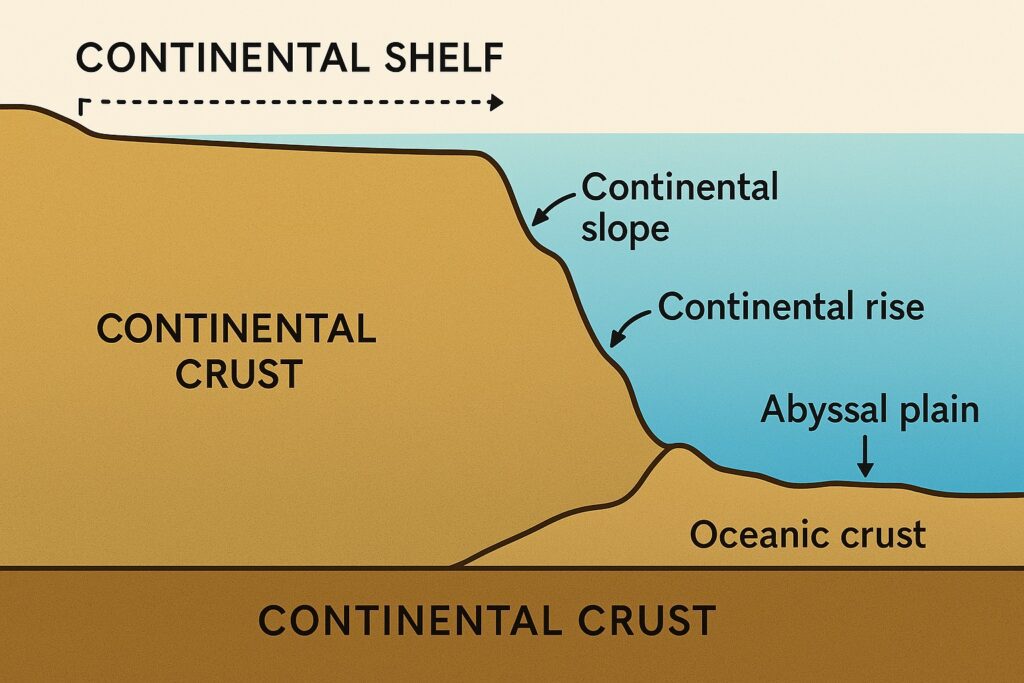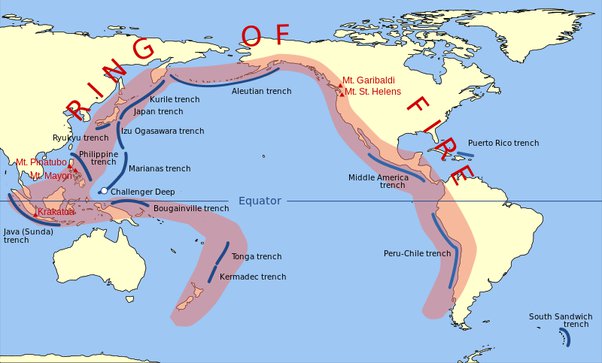The Bottom Topography of the Pacific Ocean refers to the physical features and geological structures present on the ocean floor. These features result from tectonic movements, volcanic activity, sedimentation, and erosion over millions of years. It’s the underwater landscape, much like the mountains, valleys, plains, and trenches we see on land, but hidden beneath miles of water.

Table of Contents
Introduction to Pacific Ocean
The Pacific Ocean is the largest and deepest ocean on Earth, covering over 60 million square miles and reaching depths of over 36,000 feet in some places. In this article, we will discuss the Bottom Topography of the Pacific Ocean.
The ocean floor of the Pacific is just as diverse and complex as its surface and includes a wide range of underwater features that play important roles in everything from ocean currents and weather patterns to the distribution of marine life and the location of mineral and energy resources.
"The surface area Pacific Ocean is larger than all landmasses combined."
Meaning of Bottom Topography
Bottom topography refers to the physical features and variations in elevation found on the ocean floor, such as trenches, ridges, seamounts, abyssal plains, and guyots. It is essentially the “landscape” beneath the sea, shaped by geological processes like plate tectonics, volcanic activity, and sediment deposition. Studying bottom topography helps scientists understand the structure of the Earth’s crust, predict tectonic movements, explore marine resources, and improve navigation and oceanographic research.
Division of Pacific Ocean
The Pacific Ocean is broadly divided into four sub-regions: the North Pacific Ocean, South Pacific Ocean, Eastern Pacific Ocean, and Western Pacific Ocean.
- The North Pacific Ocean lies north of the equator, bordered by eastern Asia to the west and North America to the east, and includes seas like the Bering Sea and Sea of Japan.
- The South Pacific Ocean lies south of the equator, stretching between Australia and South America, and is home to numerous island nations such as Fiji and Tonga.
- The Eastern Pacific Ocean runs along the western coasts of North and South America and features major geological structures like the Peru-Chile Trench, it is also significantly influenced by oceanic phenomena such as El Nino.
- The Western Pacific Ocean borders the eastern coasts of Asia and Australia, is highly tectonically active, and includes some of the world’s deepest trenches and important seas such as the South China Sea and Coral Sea. These sub-regions help oceanographers and geographers better understand the diverse physical, climatic, and ecological characteristics of the Pacific Ocean.
Features of Bottom Topography of Pacific Ocean
Continental Shelf of the Pacific Ocean
The continental shelf of the Pacific Ocean is the submerged extension of continental landmasses that slopes gently before dropping into the deep ocean. It serves as a critical zone for marine ecosystems, economic activities, and geological processes. The shelf varies in width and depth depending on the tectonic and sedimentary conditions of different regions.

- The Pacific Ocean’s continental shelves are most extensive along the western Pacific, near Asia and Australia, while relatively narrow along the eastern Pacific, near North and South America.
- The shelf extends from the shoreline to depths of around 200 meters (656 feet) before transitioning into the continental slope.
- Bering Sea Shelf – One of the largest and widest continental shelves, located off Alaska and extending into Russian waters.
- East China Sea Shelf – A broad shelf influenced by sediment inflow from the Yangtze River, rich in marine biodiversity.
- Australian Shelf – Located off the northern and eastern coast of Australia, supporting diverse coral reef systems, including the Great Barrier Reef.
- Peruvian and Chilean Shelves – Comparatively narrow due to active subduction zones that lead to steep ocean floor transitions.
- Formed by sediments deposited over millions of years, including sand, silt, and organic material from rivers and coastal erosion.
- The shelf contains significant oil, gas, and mineral deposits, making it economically vital.
- Marine Biodiversity: Supports coral reefs, fisheries, and deep-sea ecosystems.
- Fishing Grounds: Major fisheries thrive along the shelves due to nutrient-rich waters from upwelling currents.
- Natural Resources: Contains oil and gas reserves that contribute to global energy supplies.
Continental Slope
-
The continental slope is the steep slope between the continental shelf and the deep ocean floor.
-
In the Pacific Ocean, the slope is often narrow and steep, especially along the active margins like the coasts of North and South America and East Asia.
-
It marks the transition from the relatively shallow continental shelf to the deep ocean basin.
-
Due to tectonic activity, especially subduction zones, the slope in the Pacific is more dramatic compared to the Atlantic.
-
Features like submarine canyons are common, formed by underwater erosion and sediment transport.
Continental Rise
-
The continental rise lies beyond the continental slope and is characterized by a gentler gradient.
-
It is formed by the accumulation of sediments that cascade down the slope through turbidity currents.
-
In the Pacific Ocean, the continental rise is less developed or even absent in many regions with active margins (like the “Ring of Fire”) because trenches replace the rise.
-
However, in regions with passive margins, such as parts of the western Pacific near Australia, a more defined rise can be observed.

Abyssal Plains of Pacific Ocean
Abyssal plains are vast, flat, and deep areas of the ocean floor found at depths of 3,000 to 6,000 meters. They are covered by fine-grained sediments like clay and microscopic marine organisms that settle slowly over time.
-
The Pacific Ocean has fewer and less extensive abyssal plains compared to the Atlantic.
-
This is because much of the Pacific has tectonically active margins with deep oceanic trenches that interrupt the formation of flat plains. However, some notable abyssal plains do exist, particularly in the central and western Pacific, such as Clarion-Clipperton Zone, Peru Basin and Nauru Basin.
-
Abyssal plains in the Pacific are often interrupted by seamounts, guyots, and fracture zones.
-
They are areas of sediment accumulation and may contain valuable minerals like manganese nodules.
-
These plains provide crucial habitats for deep-sea organisms and are important in oceanic carbon cycling.
East Pacific Rise
This ridge runs along the eastern side of the Pacific and is an active divergent boundary where tectonic plates—such as the Pacific Plate and the Nazca Plate—are spreading apart. As a result, magma rises to the surface, creating new oceanic crust.
Unlike the Mid-Atlantic Ridge, which runs through the center of the Atlantic Ocean, the East Pacific Rise is characterized by fast-spreading rates, leading to a relatively smooth topography compared to slow-spreading ridges.
"The Pacific Ocean is bordered by the Ring of Fire, an area with intense volcanic activity and earthquakes."
Trenches
Oceanic trenches are the deepest parts of the ocean floor, formed by the process of subduction, where one tectonic plate sinks beneath another. The Pacific Ocean is home to the majority of the world’s oceanic trenches, making it the most tectonically active ocean.
- Trenches are typically found along convergent plate boundaries.
- They are long, narrow, and deep depressions that can reach depths over 11,000 meters.
- Associated with intense seismic and volcanic activity, including earthquakes and tsunamis.
- Trenches play a vital role in plate tectonics and recycling of the Earth’s crust.
- They are also key to understanding earthquake generation, tsunami formation, and deep-sea ecosystems.

Major Trenches in the Pacific Ocean
- Mariana Trench
- Deepest ocean trench in the world (approx. 11,034 meters deep).
- Located east of the Mariana Islands.
- Peru-Chile Trench (also called Atacama Trench)
- Runs along the west coast of South America.
- Formed where the Nazca Plate subducts beneath the South American Plate.
- Philippine Trench
- East of the Philippines.
- Formed by the subduction of the Philippine Sea Plate.
- Tonga Trench
- Located in the South Pacific, near Tonga and New Zealand.
- Among the deepest trenches.
- Kuril and Japan Trenches
- Located off the coasts of Japan and Russia.
- Sites of frequent seismic activity, including major earthquakes.
- Kermadec Trench
- North of New Zealand, continuation of the Tonga Trench.
Oceanic Plateaus
The oceanic plateaus in the Pacific Ocean include the Shatsky Rise and the Ontong Java Plateau. These plateaus are large underwater massifs that rise several thousand meters above the surrounding abyssal plain. They are formed by volcanic activity and are characterized by a variety of topographic features, including seamounts, ridges, and valleys.
The Shatsky Rise is a large oceanic plateau located in the northwestern Pacific Ocean. It is believed to have formed as a result of hotspot volcanic activity, which caused large volumes of molten rock to rise from the mantle and solidify on the ocean floor. Over time, the plateau has been shaped by erosion and other geologic processes, creating the rugged and diverse topography that is visible today.
The Ontong Java Plateau is a large submarine plateau located in the western Pacific Ocean. It is considered to be one of the largest oceanic plateaus in the world, and is characterized by a series of large seamounts and volcanic ridges that rise several thousand meters above the surrounding abyssal plain. The plateau is believed to have formed as a result of tectonic plate movement and volcanic activity, and is considered to be one of the most geologically active regions in the Pacific Ocean.
Importance of Bottom Topography of Pacific Ocean
The bottom topography of the Pacific Ocean is important for a variety of scientific, economic, and strategic reasons. For example, the ocean floor is home to a wide range of valuable mineral resources, including manganese nodules, hydrothermal vents, and other minerals that are critical to modern industry and technology. In addition, the ocean floor plays a key role in the Earth’s climate system, influencing the distribution of ocean currents, the amount of heat that is stored in the ocean, and the exchange of carbon dioxide between the atmosphere and the ocean.